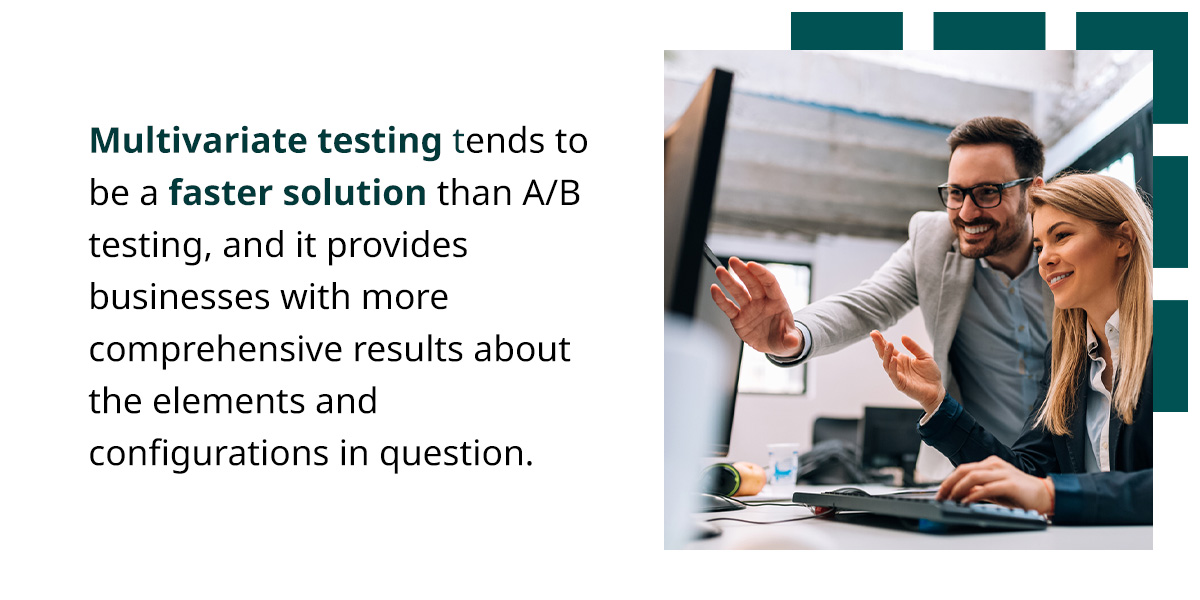As customers continue to demand more personalized and effortless experiences, there’s a growing importance for organizations to understand customer behavior and preferences. This requires data-driven decision making to inform customer journey and experience strategies to stay competitive. For that reason, organizations across all industries are looking to invest in journey analytics to gain more insight and optimize experiences more quickly.
With customer experience optimization leading the way in organizational priorities, businesses are looking for more robust analytics and testing than traditional A/B testing might provide.
Enter multivariate testing.
What is Multivariate Testing?
Multivariate testing (MVT) refers to a technique businesses use to test multiple variations of an interaction to determine which one performs the best. While most people know MVT to be used for traditional marketing tactics (i.e., A/B testing email templates for conversion), MVT’s capabilities far surpass that.
Multivariate testing helps determine which combination of variables produces the best results. This method is used when there are multiple variables that could affect customer behavior, and it’s not clear which variable is most impactful.
For example, a travel website may test several different combinations of flight prices, departure times and airlines to determine which combination produces the highest conversion rate.
After completing multivariate testing, you can easily compare the variables in question and analyze the performance of each version. The test’s results will provide you with a complete overview of which configuration performed best over the others and which key elements contributed to its success.
MVT is a powerful tool for determining what changes to specific details and features will have the greatest impact on your material’s performance. You can use the data you receive from this type of testing to make better decisions and create more effective designs and customer interactions.
What Is A/B Testing?
A/B testing consists of testing two variations of a single variable (A and B) against each other to determine which one performs better. This method is commonly used to test changes in headlines, copy, images or colors.
For example, an e-commerce company may test two different versions of a product page, one with a red “buy” button and another with a green “buy” button, to see which one generates more sales.
While A/B testing is a great way to experiment with new ideas and can be a very versatile tool, this method has some fundamental limitations too.
One con of A/B testing is how long it can take to get meaningful results. For instance, using this method for the design of a website page that has limited monthly visitors could come back with inconclusive results because there is not enough data to determine which option is best. Getting A/B testing results can also take a long time for the same reasons. Another downside is that this method won’t help you if there are other fundamental issues with the material you’re testing.
Differences Between A/B Testing vs. Multivariate Testing
MVT and A/B testing are both experimentation methods used in marketing, product design and user experience research. The main difference between these two methods is the number of variables being tested.
MVT transcends A/B testing because it can optimize an entire experience. While A/B testing is traditionally used for simple use cases, MVT can test entire journeys against one another using machine learning.
An example is testing whether SMS or email is more effective in engaging the customer. When you test these strategies, it enables adaptive learning to pick the winner and naturally flow customers to the “winning experience.”
Which Testing Method Is Better?
While A/B testing and multivariate testing have both pros and cons, MVT tends to be the best option for optimizing your approach to design and customer experience.
Multivariate testing tends to be a faster solution than A/B testing, and it provides businesses with more comprehensive results about the elements and configurations in question.
When to Use Each Testing Method
The best testing method to use will ultimately depend on your business’s unique needs and objectives. In general, A/B testing is a good pick for choosing between two versions that are drastically different from each other. Multivariate testing is generally better for analyzing numerous element variations at once.
How Can Multivariate Testing Be Used to Optimize Customer Experience?
MVT helps to optimize experiences at the journey, channel and action level using machine learning.
Action Level
At the action level, by testing different variables that influence customer behavior and decision-making, businesses can identify the optimal combination of variables that lead to the desired customer action. Think of this as traditional marketing testing. For example, by testing different versions of a call-to-action button, businesses can identify the button that produces the most conversions.
Channel Level
At the channel level, MVT can be used to conduct channel-specific tests to identify the variables that are most important for each channel and optimize the experience accordingly. This is a more dynamic level of testing. Customers interact with businesses through multiple channels, and their experience across different channels can impact their overall perception of the brand. MVT can also conduct cross-channel tests, so businesses can identify the variables that impact customer experience across channels and optimize the customer experience to create a seamless and consistent experience across channels.
Journey Level
At the journey level, MVT can optimize the entire customer experience by identifying the most effective combination of variables that influence customer behavior throughout the customer journey. MVT can help to identify which journey touchpoints have the most significant impact on customer behavior. Additionally, by analyzing customer behavior data, machine learning algorithms can predict which variables are most likely to impact customer behavior at each touchpoint and recommend the most effective strategies to optimize the customer experience. At this level, cadence of communication and sentiment are optimized as well. For example, if you are selling an exclusive high-level offer, MVT can optimize the experience to ensure that the general tone of communication is delivered with excitement versus a collections reminder notice may be given with firm tone and sentiment.
Related Resource: State of the Customer Experience 2023 Report
What Are the Benefits of Multivariate Testing as It Relates to Customer Journeys?
MVT is important for customer journeys because it allows you to identify the most effective combination of touchpoints, messages and content across the entire process. By testing multiple variations of different elements at each stage of the journey, you can determine which combination is most effective in driving conversions, retention and loyalty.
Here are specific reasons why multivariate testing is important for customer journeys:
1. Optimization of Touchpoints
With MVT, you can identify the most effective combination of touchpoints to guide customers through each stage of the journey. For example, you can test different variations of landing pages, emails, text messages and content to determine which combination is most effective in driving engagement, retention and conversion.
Understanding how your customers respond to your touchpoints gives you valuable information about what strategies will perform better in the future and why.
2. Personalization
MVT allows you to tailor the customer journey to each customer by testing different variations of content and messages. By understanding which combination is most effective for each customer segment, you can create a more personalized experience that resonates with their specific needs and preferences.
Leveraging multivariate testing to offer more personalization can boost your customer experiences and engagement.
3. Continuous Improvement
MVT enables you to continuously refine and optimize the customer journey over time. By regularly testing different variations, you can identify areas for improvement and implement changes that drive better results.
This testing method can help you determine what elements work well for your audience. You can then use that knowledge to continue to create more effective designs and deliver increasingly better results to your customers.
Related Blog: CX Is More Than Voice of Customer: Employees, Business and Process Need a Say, Too
How Is Traditional Marketing Multivariate Testing Different from Journey Orchestration Multivariate Testing?
The key difference between traditional marketing MVT and journey orchestration MVT is the scope of the testing and the level of personalization involved. Traditional marketing MVT typically focuses on testing different versions of individual elements within a campaign, such as the headline, images or call-to-action button. The goal is to determine which version of each element performs best in terms of generating clicks, conversions or other desired outcomes. This type of testing is often used to optimize individual campaigns or website pages.
Journey orchestration MVT, on the other hand, takes a broader approach by testing different versions of the entire customer journey. The testing covers the entire customer lifecycle from acquisition to retention, and engagement, not solely just conversion. Journey orchestration MVT takes test results from the traditional marketing process and leverages them in the engagement process (e.g., preferred channel, preferred product feature, etc.) This involves testing different touchpoints across multiple channels, such as email, app and website interactions, to determine which combination of touchpoints generates the best overall customer experience and desired outcomes. Rather than testing a single version of a campaign or website element, different versions of the journey are tested based on individual customer behavior, preferences and needs. This allows businesses to create highly personalized and intelligent journeys that are tailored to the needs of each individual customer and deliver results beyond campaign performance.
CSG Xponent: Experience Optimization Through Multivariate Testing
With CSG Xponent’s journey analytics, you can take action with data-led insights and understand customer interactions, helping you enhance customer journeys and overall CX to expand customer lifetime value. Beyond just understanding traditional campaign performance, CSG Xponent takes multivariate testing a level deeper, analyzing customer interaction across a variety of channels, touchpoints and messages to drive customer action.
CSG Xponent can help you test:
-
-
- Which content is most engaging
- Which channel is most effective in reaching customers
- Which actions make the CX more effortless
- Entire journeys, to ensure return on investment
-
Contact CSG To Learn More About Optimizing Customer Experience
Interested in optimizing your customer engagement? Check out the solutions from CSG.
With CSG Xponent Ignite, you’ll enjoy pre-built journeys for various industries, including financial services, telecommunications, health care and retail. You’ll also access powerful reporting and testing capabilities to boost your customer journeys, experiences and your overall bottom line.
Let’s make your data actionable and optimize your entire CX. Contact CSG to get started today!



